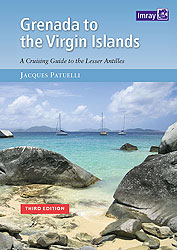
Destinations
Map of Lesser Antilles
Everything about
archipelago
Sailing in the Lesser
Antilles(charts with
routes and wp)
Services directory
(Blue pages)
Order the guide
Mail
Last informations
Warning

Grenada


|
When the island was discovered by
Columbus on his third voyage in 1498,
he baptized it Concepcion. Only later
did the Spanish sailors give it the name
it has today because they likened its
green hills to those above Granada in
Spain’s Andalusia. The English kept the
name once they tried colonizing the
island in 1609. |
It was a classic scenario: the Caribs ate some of the invaders and threw the rest back into the sea! Then in 1650 the French arrived from Martinique. They were better informed and bargained for the island with some trinkets and alcohol. Once they’d got over the hangover the Caribs knew they’d been cheated and fought back. The French hung on and, by 1651, had penned the Caribs up on the edge of a high cliff on the N coast. Rather than surrender, the Caribs jumped into the void. Hence the name you’ll still find, Morne des Sauteurs (literally Jumpers’ Bluff, though locally called Caribs’ Leap). With the Caribs wiped out, the usual scenario resumed. For a century and a half the English fought the French for the lovely, fertile island of Grenada. It took two treaties, of Paris in 1763 and, after a last push by the French, of Versailles in 1783, for the place to become definitively English. After Cyclone Janet caused serious damage in 1955, the island first became an associated state of the Commonwealth in 1967, then an independent member in 1974. |
|
|||||



